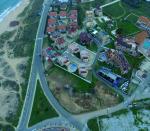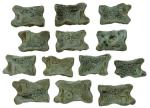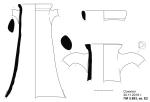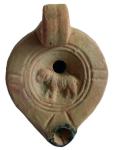Summary (English)
APOLLONIA (Krastina Panaiotova – kpanayotova@abv.bg, Margarit Damyanov) Occasional finds were discovered on the site: a silver tornese of the 12th century and a Late Mediaeval bronze finger-ring. Terraces into the volcanic bedrock were documented, situated along the slope and used as a stone quarry. Single burials were carried out on the terraces some time after the quarrying was completed. Five inhumation burials were discovered, dated from the mid 5th century BC to AD 200 – 250. The bodies were laid in pits dug into the bedrock. The heads of the bodies in the burials from the Classical and Hellenistic periods were oriented to the east. The grave goods in Grave No. 2 included two lekythoi of the mid 5th century BC, a bronze strigil and c. 131 knucklebones with different size, placed over the knees of the dead, probably in a small wooden box with an iron handle. Greek letters were incised on 14 knucklebones: Α, Β, Γ, Ε, Ι, К, Н (twice), Δ (three times) and ПНΘ. The grave goods in Grave No. 4 of the mid 4th century BC included a ceramic alabastron, a lekythos, a bronze strigil and 55 knucklebones, probably accommodated in a small wooden box with an iron handle. The burial pit of Grave No. 5 of 300 – 250 BC was fired and subsequently covered with six tegulae, one of them with a stamp that read: HPA, probably an abbreviation of the personal name Ηρακλείδης. The burial pit was covered with uneven stones and a small black-gloss dish, an oinochoe and sherds from amphorae were discovered among them. Grave No. 1 dated to AD 200 – 250. The body was laid supine with his head to the west. There was a bronze stamp finger-ring on the left hand of the dead and the grave goods included a jug, a cup and a terracotta lamp showing a ram in relief. The orientation of the body and the lamp decorated with one of the early Christian symbols allow us to suppose that the dead was a member of the early Christian community in Apollonia. The community was attested as early as the middle of the 2nd century AD; Aulus Poplius Iulius, the Bishop of Apollonia and Deultum, died as a martyr.
- Krastina Panaiotova - Archaeological Institute with Museum
- Margarit Damyanov - Archaeological Institute with Museum
Director
- Krastina Panaiotova - Archaeological Institute with Museum
- Margarit Damyanov - Archaeological Institute with Museum
Team
Research Body
- Archaeological Institute with Museum






![Download [PDF]](/excavation/skins/fasti/images/results/download_sml.png)



